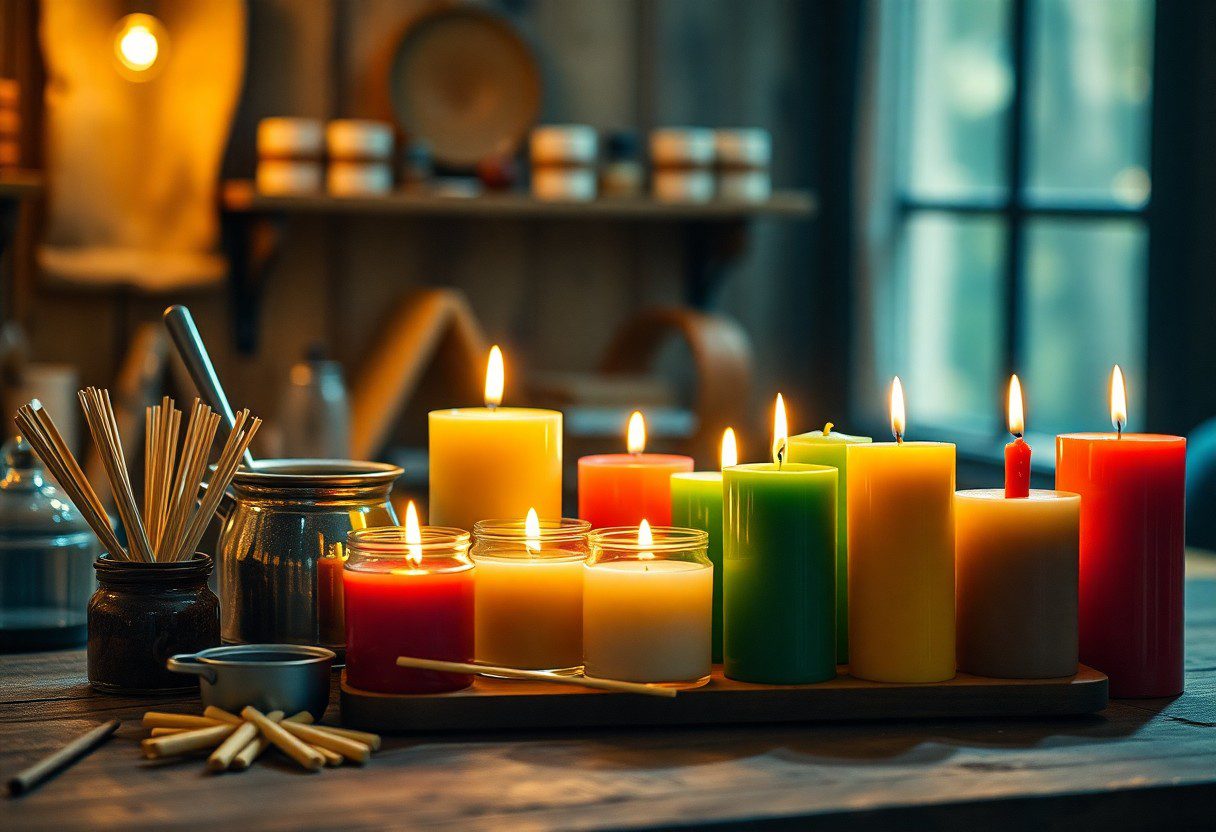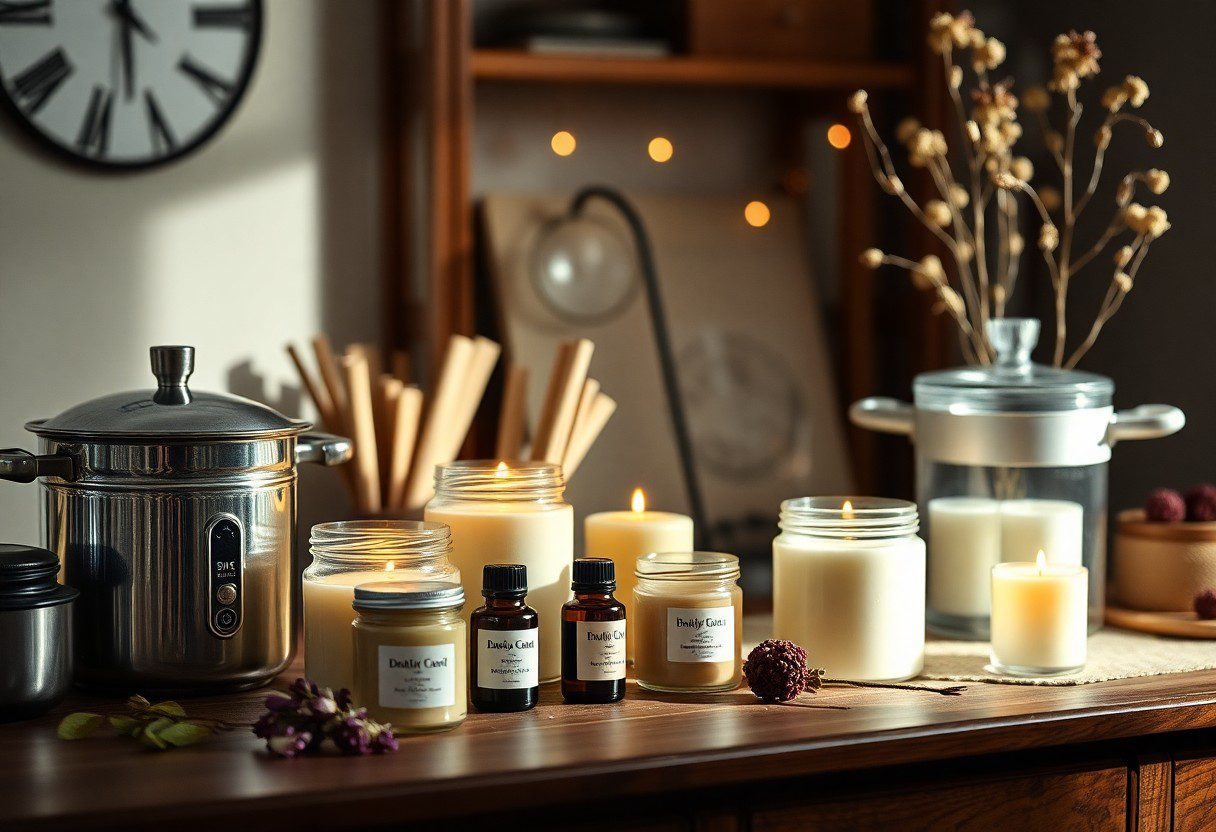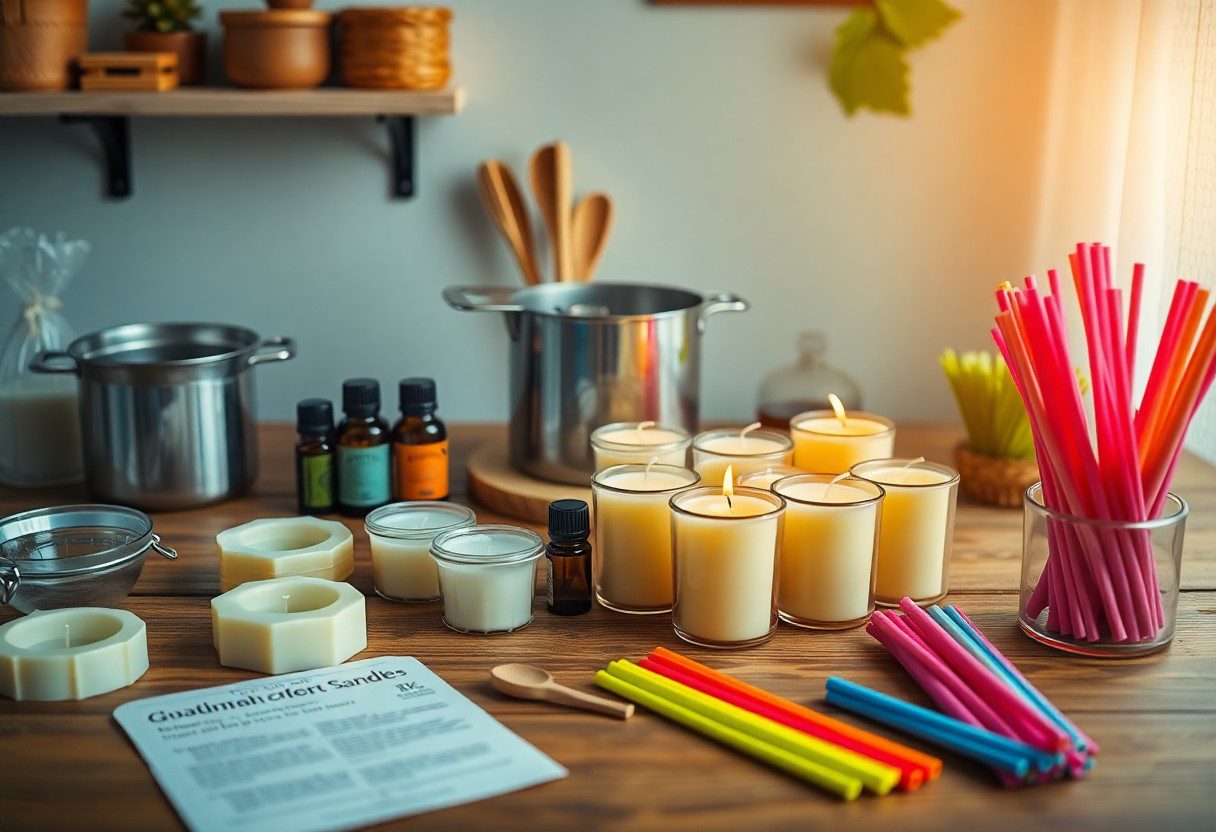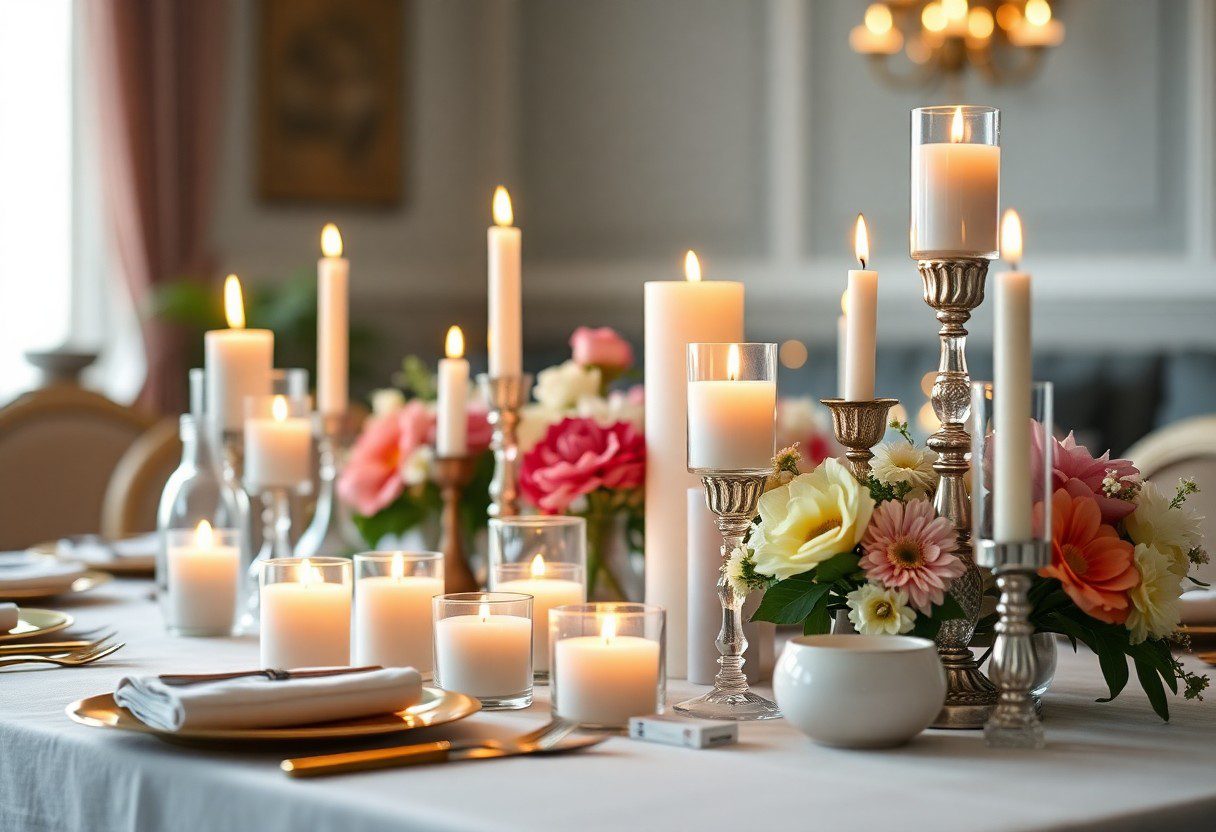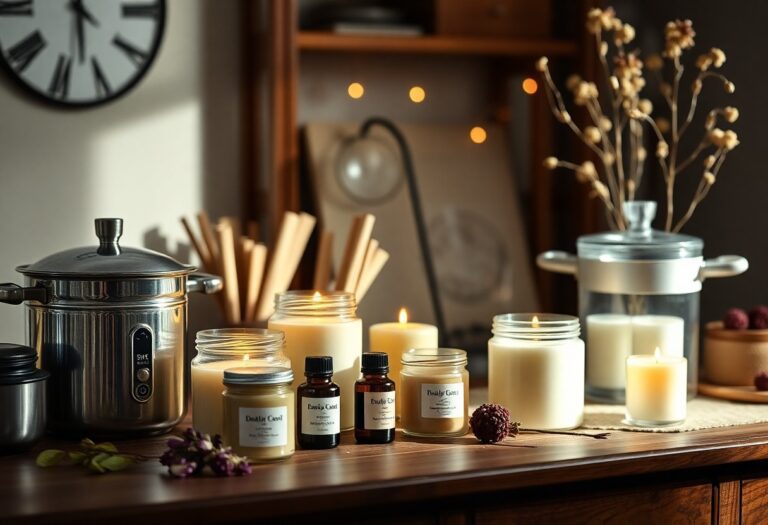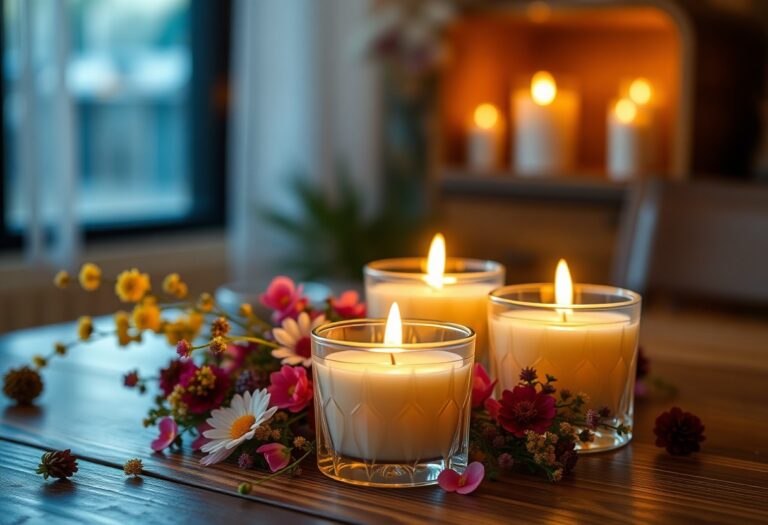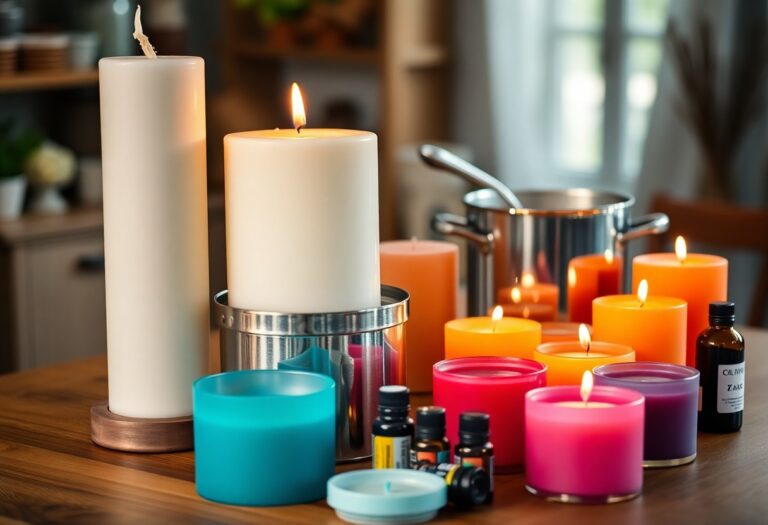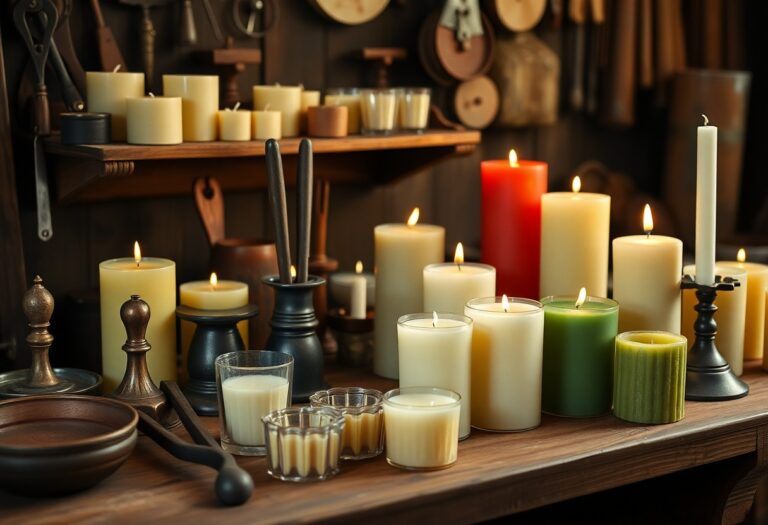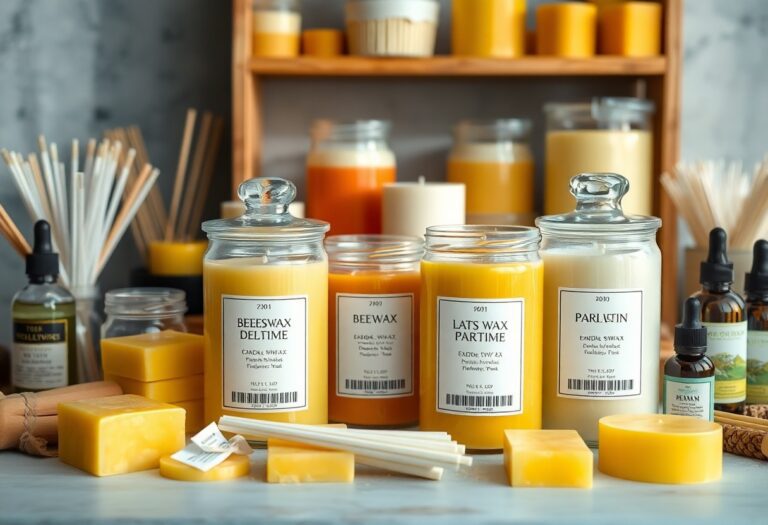The Ultimate Guide To Basic Candle Making Steps – Create Your Own Masterpieces
Crafting your own candles is a fulfilling and creative endeavor that allows you to express your personal style while enjoying the relaxing atmosphere they bring to your space. In this guide, you will explore necessary steps in the candle making process, from selecting the right wax and wick to adding captivating scents and colors. By following these straightforward techniques, you’ll have the opportunity to create stunning masterpieces that make perfect gifts or delightful decor for your home. Let’s investigate transforming your candle-making dreams into reality!
Types of Candles
Your exploration of candle making begins with understanding the different types of candles available. Each type brings unique characteristics and benefits that cater to your preferences and needs. Here’s a breakdown:
| Type | Description |
| Paraffin Candles | Traditional candles made from petroleum byproducts. |
| Soy Candles | Eco-friendly candles made from soybeans. |
| Beeswax Candles | Natural candles produced by bees, known for their clean burn. |
| Gel Candles | Translucent candles made with a gel-like substance. |
| Container Candles | Candles poured into jars or containers for easy use. |
Assume that you want a versatile option; exploring each type will enhance your candle-making skills and create stunning masterpieces.
Paraffin Candles
Candles made from paraffin wax are among the most common types found in the market. They are affordable, come in a variety of colors and scents, making them popular for various occasions. However, they can release potentially harmful fumes when burned, which is something to consider if you are concerned about air quality.
Soy Candles
One of the most popular eco-friendly options available is soy candles, which are made from the oil of soybeans. They burn cleaner than paraffin and are biodegradable, making them a sustainable choice for environmentally-conscious candle lovers.
Paraffin wax, derived from petroleum, can emit toxic emissions when burned, whereas soy candles release fewer pollutants, providing a better indoor air quality experience. Additionally, they have a good scent throw, making them ideal for filling your space with delightful aromas.
Beeswax Candles
Candles made from beeswax are a natural choice, offering a warm glow and a subtle honey scent. Known for their long burn time and air-purifying properties, beeswax candles release negative ions that can help reduce indoor pollutants, benefiting your overall health.
This type of candle is considered one of the healthiest options available. Furthermore, their natural composition means they are free from synthetic fragrances and dyes, promoting a pure and safe experience for those who love ambiance.
Gel Candles
Clearly, gel candles offer a unique twist to your candle-making journey. Made from a combination of natural oils and polymer resin, gel candles are translucent and can hold various objects within them, allowing for creative designs and stunning visual effects.
To make gel candles, it’s important to use appropriate fragrance oils as not all fragrances mix well with gel. The final product is not only visually appealing but also tends to burn slower than other types, making them a long-lasting option for your home or special events.
Step-by-Step Candle Making Process
Some may find the candle making process intimidating, but with the right guidance, you can create your own masterpieces effortlessly. Start by checking out The Ultimate Guide to Easy Candle Making: Master the art …. Here’s a concise breakdown of the steps to ensure your candle making journey is smooth and enjoyable:
| Step | Details |
| Gathering Materials | Collect all necessary items before starting. |
| Melting Wax | Heat wax to the appropriate temperature. |
| Adding Fragrance and Color | Incorporate scents and dye for added appeal. |
| Pouring and Setting | Carefully pour your mixture into molds and let it cool. |
Gathering Materials
Little preparation goes a long way in ensuring your candle making is a success. Gather necessarys including wax, wicks, fragrance oils, dyes, and appropriate containers. Equipping yourself with quality materials will significantly influence the overall outcome of your creations.
Melting Wax
For optimal results, you need to melt your wax properly. Use a double boiler or a dedicated wax melter to heat the wax gently, preventing scorching or burning.
This process requires careful attention to temperature; aim for around 170-180°F depending on the type of wax. The gradual melting allows for an even texture and facilitates the integration of other components, ultimately leading to better quality candles.
Adding Fragrance and Color
For a truly personalized touch, adding fragrance and color transforms your candles. Choose necessary oils or synthetic fragrances tailored to your preferences.
To effectively infuse the desired scent and hue, introduce fragrance oils to the melted wax at the appropriate temperature (usually around 160°F). This ensures the fragrance binds well, enhancing the overall sensory experience of your candle while allowing you to create vibrant color variations as well.
Pouring and Setting
Adding the final touches, pour the wax mixture into your chosen containers while maintaining control to avoid spills and messes.
Another important aspect of this step is to allow your candles to cool undisturbed. Cooling should occur at room temperature to prevent surface imperfections, ensuring your finished pieces have a smooth, appealing finish. Take the time needed for proper curing, which enhances both scent throw and burn quality.
Essential Tips for Successful Candle Making
After you’ve gathered your supplies, keep these vital tips in mind for a rewarding candle-making experience:
- Measure Ingredients carefully to achieve the desired results.
- Control Temperature for proper wax melting and pouring.
- Use High-Quality Materials to enhance your candle’s appearance and longevity.
- Be Patient during the cooling process for smooth finishes.
Assume that following these tips will lead you to create beautiful, aromatic masterpieces.
Measuring Ingredients
With accurate measurements, you ensure your candles turn out just right. Utilize a digital scale for wax, fragrance oils, and any colorants you may be using, following recommended ratios to achieve the perfect blend. This precision results in candles that not only look great but also burn evenly.
Temperature Control
Any successful candle maker understands the importance of controlling temperature. Below are ideal temperature ranges for key processes:
| Melting Wax | 170-180°F |
| Adding Fragrance | 180-190°F |
| Pouring Wax | 150-160°F |
| Cooling Time | 4-6 hours |
Making candles involves meticulous temperature management. Pouring the wax at the correct temperature ensures that your fragrance binds well and eliminates surface imperfections. By adhering to the recommended ranges, you enhance the candle’s fragrance throw and overall quality.
Safety Precautions
The process of candle making requires a focus on safety. Always work in a well-ventilated area, use protective gear, and avoid direct contact with hot surfaces. Ensure you have a fire extinguisher nearby and keep children and pets away from your workspace for a stress-free experience.
Measuring your ingredients accurately and maintaining a safe environment is indispensable during candle making. Pay attention to the melting point of wax and maintain a controlled environment. Remembering to handle tools carefully, especially when working with heated wax or sharp instruments, will help you avoid any hazardous situations. Prioritize safety above all to ensure you create art without incident.
Factors to Consider When Making Candles
Not all candles are created equal, and several factors can impact your candle-making experience. Consider the following key points:
- Wax type
- Wick size and material
- Scent throw
- Burn time
Knowing these elements will help you create candles that not only look great but also perform well. For more insights, Discover the Joy of Creating Candles with Easy, Step-by-…
Wick Selection
Now, choosing the right wick is imperative for achieving a clean and steady burn. Consider the diameter of your candle and the type of wax you are using, as both factors influence which wick size and material will work best. A proper wick ensures a consistent flame and minimizes soot production.
Scent Throw
When you think about what makes your candles enjoyable, scent throw is a key element. This term refers to how well the fragrance disperses both while the candle is burning and when it’s unlit. Knowing how to enhance your scent throw can elevate your candle-making game.
Candles with a strong scent throw engage your senses and create memorable atmospheres. To achieve this, you’ll want to select high-quality scent oils and use the correct wax type. Too much or too little fragrance can affect the overall experience, so experimentation is key to mastering this aspect.
Burn Time
Consider the importance of burn time when crafting your candles. A well-made candle should burn for a long duration without compromising efficiency, allowing you to enjoy its beauty and scent for hours. Pay attention to the wax type and wick size to optimize this factor.
Time is of the essence when it comes to burn quality. Selecting the right combination of wax and wick not only impacts the duration of your candle but also influences the intensity of the flame. Prioritize a balanced approach to ensure your candles offer a satisfying and long-lasting burn, providing both enjoyment and safety.
Pros and Cons of Different Candle Types
All candle types have their advantages and disadvantages. Understanding these can help you make informed choices in your candle-making journey. Below is a summary of the pros and cons of various types of candles.
| Type | Pros and Cons |
|---|---|
| Paraffin | Pros: Inexpensive, excellent scent throw. Cons: Made from petroleum, can release toxins. |
| Soy | Pros: Made from renewable resources, cleaner burn. Cons: Can be more expensive, may require additives. |
| Beeswax | Pros: Natural, long burn time. Cons: Expensive, limited scents. |
| Gel | Pros: Unique appearance, holds scent well. Cons: Not as widely available, can be tricky to work with. |
| Specialty Candles | Pros: Unique designs, variety of materials. Cons: Can be pricey, often require more skill. |
Paraffin vs. Soy
Candle enthusiasts often debate between paraffin and soy wax. Paraffin is favored for its affordability and the strong scent throw, making it popular among commercial candlemakers. On the other hand, soy offers a cleaner burn and is a more environmentally friendly option, although it can come with a higher price tag. Each has its place in the candle-making world, depending on your values and goals.
Beeswax Benefits and Drawbacks
You may consider using beeswax for its natural properties. It is a renewable resource and has a long burn time compared to other waxes. Additionally, it emits negative ions, which can improve indoor air quality. However, its higher cost and lack of scent options might dissuade some candlemakers. Understanding this balance can help you decide if beeswax fits your candle-making repertoire.
To maximize your candle-making potential, consider the advantages of beeswax. It creates a warm, natural glow and burns cleaner than paraffin. Its drawback, however, remains its price point, which may limit your ability to experiment with various designs and fragrances. Engaging with beeswax can lead to exquisite creations, provided you are willing to invest more upfront.
Specialty Candles
Beeswax candles can easily be classified as specialty candles due to their unique properties and techniques required for crafting. Oftentimes, they are infused with important oils, allowing for a myriad of scents. Specialty candles can also incorporate unique shapes and designs, making them perfect for gifts or decorative purposes. However, keep in mind that their designs can be complex, requiring practice and precision to execute effectively.
It’s important to understand the fun yet challenging nature of specialty candles. They allow you to express creativity, yet they also require significant knowledge regarding materials and techniques. By honing your skills, you’ll find joy in creating beautiful pieces that shine in any setting.
Troubleshooting Common Candle-Making Issues
To achieve the best results in your candle-making journey, it’s crucial to understand how to troubleshoot common issues. As you create your masterpieces, you may encounter problems like uneven burns, soot and smoke, or lack of fragrance strength. By identifying the causes and solutions for these challenges, you can improve your techniques, ensuring that your candles are not only beautiful but also functional.
Uneven Burn
If your candles are burning unevenly, it can lead to wasted wax and an unsightly appearance. This issue often arises from improper wick sizing, inadequate scent throw, or even temperature fluctuations during the pour. To remedy this, ensure your wick is appropriate for the candle size and type of wax you’re using to promote an even melt pool.
Soot and Smoke
Issues such as soot and smoke can detract from your candle’s performance and overall enjoyment. Factors contributing to this problem include unsuitable wick material, too much fragrance oil, or drafty environments that disrupt the flame.
To minimize soot and smoke, prioritize using high-quality wicks that are appropriately sized for your candle. Additionally, limit fragrance oil concentrations; too much can prevent proper combustion, leading to undesirable smoke. Maintaining a consistent and stable burn environment by avoiding breezy areas will also promote cleaner burning.
Fragrance Strength
An underwhelming fragrance strength can leave you disappointed after spending time crafting your candles. This often occurs when the scent throw is not balanced with the wax or if the fragrance is added at an incorrect temperature.
Another way to enhance fragrance strength is to experiment with different fragrance oils and their recommended load percentages. Each wax type has its own limitations, so understanding the right temperature for incorporating fragrance will help you achieve an optimal scent throw that fills your space beautifully.
Conclusion
To wrap up, mastering the basic candle-making steps empowers you to unleash your creativity and craft unique masterpieces tailored to your taste. By understanding the materials, techniques, and safety measures outlined in this guide, you can confidently initiate on your candle-making journey. Whether you aim to create candles for personal enjoyment or as thoughtful gifts, your newfound skills will surely transform simple wax into stunning works of art. Embrace the process and enjoy every moment as you illuminate your space with your handcrafted candles.
FAQ
Q: What materials do I need to start candle making?
A: To begin your candle-making journey, you will need a few important materials: wax (such as paraffin, soy, or beeswax), wicks, fragrance oils for scent, dye for color (if desired), a double boiler or microwave for melting the wax, pouring containers (like jars or molds), and safety equipment such as gloves and goggles. It’s also helpful to have a thermometer to monitor the wax temperature, as well as a stirring utensil. With these items, you’ll be well-equipped to create beautiful candles.
Q: How can I customize the scent and color of my candles?
A: Customizing the scent and color of your candles is a fun and creative process. For fragrance, you can add important oils or fragrance oils during the melting process, typically after the wax has reached a specific temperature (usually around 185°F or 85°C). Experiment with different combinations to create unique scents. For color, you can add dye chips or liquid dye to the melted wax. Start with a small amount, as it’s easier to add more if needed. Mix thoroughly to ensure an even color throughout the candle.
Q: What are some common mistakes to avoid when making candles?
A: There are several common pitfalls that can affect your candle-making experience. One mistake is not measuring the wax and fragrance accurately, which can lead to candles that don’t burn well or have a weak scent. Additionally, pouring the wax at the wrong temperature can cause imperfections. It’s also important to ensure that the wick is the correct size for your container, as a wick that is too small will not provide enough heat, while a wick that is too large may burn too quickly. Lastly, be cautious with your workspace, keeping it clean and well-ventilated to avoid accidents. Taking your time and following the steps carefully will lead to satisfying results.

